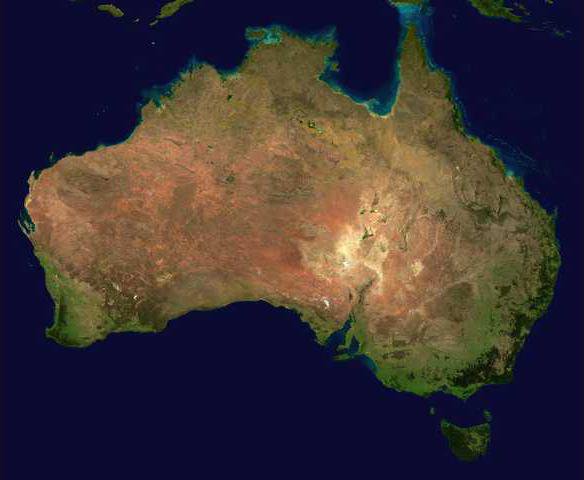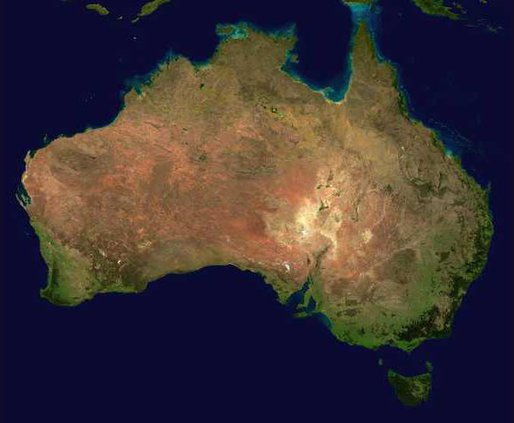Australia isnt where you think it is.
As Business Insider reported, the south Pacific continent has actually moved four times within the last 50 years, meaning its never where you think it is when you look on a map.
This happens because the country rests on a tectonic plate, which moves about 2.7 inches every year. The tectonic plate, the Indo-Australian plate, moves about 5 to 10 centimeters per year, so about the length of your fingernail, Dr. Lucia Perez-Diaz of Royal Holloway University told Business Insider.
In contrast, the North American plate moves about three times slower than the Indo-Australian plate.
"The reason why different plates move at different speeds is relatively simple: each plate is different," Perez-Diaz told Business Insider. "For each plate, its rate of motion will be determined by a balance between the forces trying to make it move and those resisting that motion."
The Australian plate is unique because all of the plates around it move, forcing pressure on the smaller plate to move quicker, according to Business Insider.
This new information may seem like just a cool fact to keep in your back pocket. But, as Business Insider reported, this continuous movement actually affects GPS devices and how Americans understand geography.
Specifically, the next generation of GPS devices will have to be more accurate when determining Australian locations.
"GPS recalibration may become a routine task in some parts of the world, but one that, in my view, is unlikely to have a great impact in most people's everyday life," Perez-Diaz said. "Most of us won't live long enough or own the same GPS device for a long enough period to have to worry about adjusting it to account for how much the plate we are standing on has moved."
Back stateside, this may have a slight impact on how American children view geography as well. Most American kids feel lost when they look at a map, according to Bloomberg.
In fact, about half of all fourth-graders could correctly identify and rank the size of North America, the United States, California and Los Angeles, the education department told Bloomberg. Moreover, fewer than one-third of elementary and high school students could show proficiency in geography.
The education department said this is because teachers are spending more time teaching about math and reading subjects to accommodate standardized tests, instead of lecturing on history, geography and social sciences.
Roger M. Downs, a Pennsylvania State University geography professor, told Business Insider that as classroom time becomes an even more precious and scarce commodity, geography, with subjects such as history and the arts, is losing out in the zero-sum game that results from high-stakes testing.
Weve seen this lack of geographic knowledge play out in everyday life. Gary Johnson, the libertarian candidate for president, didnt know what Aleppo, the center of the Syrian civil war and refugee conflicts, was in an interview earlier this month.
Educational organizations have offered ideas on how to fix Americas ailing geography problems. Edutopia, an online education community that offers ideas on how to fix education, said there are five easy-to-use resources out there that teachers can use to help children learn about locations around the world.
Google Maps is the easiest and most popular, since teachers can use it to build world tours and show children real-life places through street view. Similarly, Google Lit Trips mixes literature and geography, showing children locations around the world through the eyes of their favorite literary characters.
Other popular geography programs include Ordnance Survey, a website out of the UK that offers family friendly activities to help children learn about the world, and GeogSpace, an Australian-based website that helps teachers build lesson plans about geography.
As Business Insider reported, the south Pacific continent has actually moved four times within the last 50 years, meaning its never where you think it is when you look on a map.
This happens because the country rests on a tectonic plate, which moves about 2.7 inches every year. The tectonic plate, the Indo-Australian plate, moves about 5 to 10 centimeters per year, so about the length of your fingernail, Dr. Lucia Perez-Diaz of Royal Holloway University told Business Insider.
In contrast, the North American plate moves about three times slower than the Indo-Australian plate.
"The reason why different plates move at different speeds is relatively simple: each plate is different," Perez-Diaz told Business Insider. "For each plate, its rate of motion will be determined by a balance between the forces trying to make it move and those resisting that motion."
The Australian plate is unique because all of the plates around it move, forcing pressure on the smaller plate to move quicker, according to Business Insider.
This new information may seem like just a cool fact to keep in your back pocket. But, as Business Insider reported, this continuous movement actually affects GPS devices and how Americans understand geography.
Specifically, the next generation of GPS devices will have to be more accurate when determining Australian locations.
"GPS recalibration may become a routine task in some parts of the world, but one that, in my view, is unlikely to have a great impact in most people's everyday life," Perez-Diaz said. "Most of us won't live long enough or own the same GPS device for a long enough period to have to worry about adjusting it to account for how much the plate we are standing on has moved."
Back stateside, this may have a slight impact on how American children view geography as well. Most American kids feel lost when they look at a map, according to Bloomberg.
In fact, about half of all fourth-graders could correctly identify and rank the size of North America, the United States, California and Los Angeles, the education department told Bloomberg. Moreover, fewer than one-third of elementary and high school students could show proficiency in geography.
The education department said this is because teachers are spending more time teaching about math and reading subjects to accommodate standardized tests, instead of lecturing on history, geography and social sciences.
Roger M. Downs, a Pennsylvania State University geography professor, told Business Insider that as classroom time becomes an even more precious and scarce commodity, geography, with subjects such as history and the arts, is losing out in the zero-sum game that results from high-stakes testing.
Weve seen this lack of geographic knowledge play out in everyday life. Gary Johnson, the libertarian candidate for president, didnt know what Aleppo, the center of the Syrian civil war and refugee conflicts, was in an interview earlier this month.
Educational organizations have offered ideas on how to fix Americas ailing geography problems. Edutopia, an online education community that offers ideas on how to fix education, said there are five easy-to-use resources out there that teachers can use to help children learn about locations around the world.
Google Maps is the easiest and most popular, since teachers can use it to build world tours and show children real-life places through street view. Similarly, Google Lit Trips mixes literature and geography, showing children locations around the world through the eyes of their favorite literary characters.
Other popular geography programs include Ordnance Survey, a website out of the UK that offers family friendly activities to help children learn about the world, and GeogSpace, an Australian-based website that helps teachers build lesson plans about geography.





